Vincent Audio PHO-300 phono pream by Tim Barrall
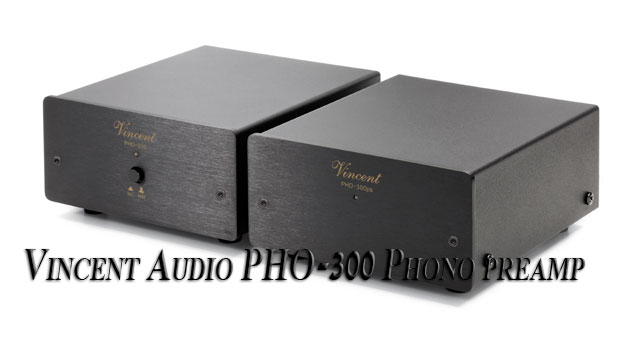
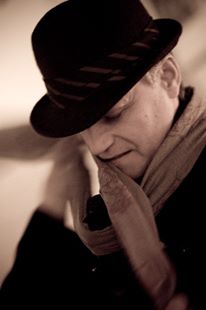 I recently reviewed the Vincent SV-200 integrated amp for Adam Sohmer, the public relations rep for Vincent Audio. Some months after that review, he reached out and wanted to know if I’d be interested in reviewing the Vincent PHO-300 phono preamp, a recent Vincent Audio release. Yes, please! Just let me know when it’s available, I replied. I was interested in hearing it paired with the Vincent SV-200 integrated amp, which I still had here on loan. From that SV-200, I knew how well Vincent products perform.
I recently reviewed the Vincent SV-200 integrated amp for Adam Sohmer, the public relations rep for Vincent Audio. Some months after that review, he reached out and wanted to know if I’d be interested in reviewing the Vincent PHO-300 phono preamp, a recent Vincent Audio release. Yes, please! Just let me know when it’s available, I replied. I was interested in hearing it paired with the Vincent SV-200 integrated amp, which I still had here on loan. From that SV-200, I knew how well Vincent products perform.
I have a nice vinyl collection, amassed throughout my decades of New York City living. I managed to get a lot of it from Tower Records and the Tower Records Sales Annex, two of my preferred haunts back in the day. I get the most joy from stumbling onto unnoticed records at used record stores and yard sales. I often get a vibe from the artist and record label, as I reach in, gently lifting the record from its cover, feeling the weight, and inspecting the disk for any scratches or wear. How fun it is when you find something worthwhile!
The PHO-300 arrived via Fed-Ex from Pangea, Vincent Audio’s American distributor. The shipping box was similar to Vincent SV-200’s, nice and compact. As I opened the box, the PHO-300 phono’s two components were neatly snuggled in preformed styrofoam, with the PHO 300 phono preamp and its separate power supply each individually wrapped in cloth bags.
Lifting the units out, I noted the power supply was slightly heavier by feel. Unveiling these electronics revealed a simple, clean design aesthetic, similar to that of the Vincent Integrated amp and the other Vincent amps. Accompanying the components were a short 5 pin DIN cable and C7 style power cable, along with a nicely printed owners manual.
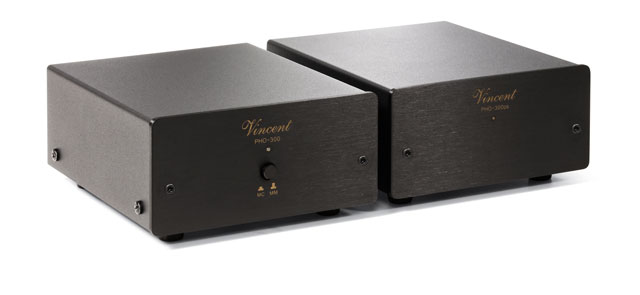
 Each unit is 4.375 wide x 5″ deep x 2.375″ high, and the pair present a tiny foot print when stacked, with the power supply resting atop the phono stage, as mentioned in the brochure. The PHO-300 is designed to perform the correction of the RIAA distortion, which allows the user to connect a record player to an amplifier without a phono input. The PHO-300 components retail together for $349.95.
Each unit is 4.375 wide x 5″ deep x 2.375″ high, and the pair present a tiny foot print when stacked, with the power supply resting atop the phono stage, as mentioned in the brochure. The PHO-300 is designed to perform the correction of the RIAA distortion, which allows the user to connect a record player to an amplifier without a phono input. The PHO-300 components retail together for $349.95.
An Easy Setup
I decided to audition the newcomer in my NYC apartment, where the Vincent SV-200 integrated amp was currently located. The set up was relatively easy – the instructions said to attach the one 5 pin DIN connector cable to the back of each unit, then install the power cable to the power supply. My record player there is the Project RPM-3, fitted with a Sumiko Bluepoint high output moving coil.
The phono cable I use is a one-meter ultra-low impedance interconnect made by customcans.co.uk. Each wire consists of 84 strands of Litz copper wire with a silk thread wrapping, and a separate thin earth ground wire is woven. This cable connects to the phono preamp input section, attaching the ground wire there as well. From the phono amp outputs, I used Sunshine interconnects to the source 1 input section of Vincent SV-200. From there, I plugged the PHO-PS power supply into a wall outlet using the supplied C7 power cable.
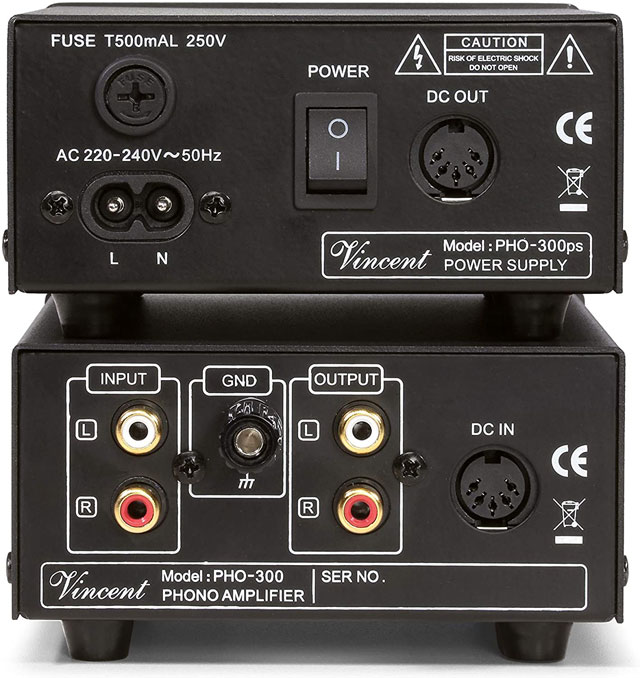
 The instruction manual says to turn on the power supply first before anything else in the system. A convenient rocker switch is located on the upper back of the power supply. I noted a red power light appeared on the power supply when it powered on, and, after a 6-second delay, a phono preamp light turned as well. With the phono stage and it’s PS now on, I fired up the SV-200 integrated amp. In this City rig, the music is voiced through a pair of Panasonic SP-BS22-LR monitors, tethered by Sunshine speaker wire to the integrated amp. I let the gear warm-up for about 15 minutes.
The instruction manual says to turn on the power supply first before anything else in the system. A convenient rocker switch is located on the upper back of the power supply. I noted a red power light appeared on the power supply when it powered on, and, after a 6-second delay, a phono preamp light turned as well. With the phono stage and it’s PS now on, I fired up the SV-200 integrated amp. In this City rig, the music is voiced through a pair of Panasonic SP-BS22-LR monitors, tethered by Sunshine speaker wire to the integrated amp. I let the gear warm-up for about 15 minutes.
On the front of the Vincent Audio PHO 300 is a button for setting the kind of cartridge you’re using, MM or MC. A push in is for a moving coil, the out position is for moving magnet cartridges). With my original Blue Point considered a high output MC (2.5 mV), the manual suggests using the MM setting. The recommended cartridge tracking force is between 1.6 to 2 grams. Using a jeweler’s digital scale, I set it at 1.8 grams.
First Listen
I have a fair amount of vintage records, so I grabbed a few for this first listening session. My brother-in-law, Greg, is always kidding me about some of my “schmaltzy” albums, referring to them as “Tim music.” Still, he’s often surprised how good some sound. It’s all about the recording process and effort – from the master tape to the record pressing in those vintage years, what’s in those grooves is there forever. That is so reassuring to me. I love my vinyl, music captured in time.
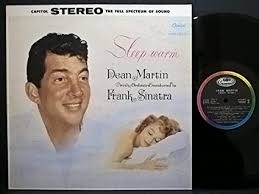 I thought I’d start off with Dean Martin and Frank Sinatra’s era. On deck was Dean Martin’s album “Sleep Warm,” (Capitol Records, ST-1150), from 1959, with the orchestra conducted by Frank Sinatra himself. The first song, “Sleep Warm,” Dean’s voice sounds perfectly silky. You can imagine him singing into an old-style tube microphone. As the instruments entered in, I could sense a little tightness in the sound. As the album reached the last song, the PHO-300 began sounding much more relaxed, producing a much deeper sound stage. With horns punchy and bright (but not glaring) and strings silky and sweet, my first impression of this phono stage was positive. The Vincent Audio PHO-300 has a beautiful warm signature that allows the delicate highs to come through when needed.
I thought I’d start off with Dean Martin and Frank Sinatra’s era. On deck was Dean Martin’s album “Sleep Warm,” (Capitol Records, ST-1150), from 1959, with the orchestra conducted by Frank Sinatra himself. The first song, “Sleep Warm,” Dean’s voice sounds perfectly silky. You can imagine him singing into an old-style tube microphone. As the instruments entered in, I could sense a little tightness in the sound. As the album reached the last song, the PHO-300 began sounding much more relaxed, producing a much deeper sound stage. With horns punchy and bright (but not glaring) and strings silky and sweet, my first impression of this phono stage was positive. The Vincent Audio PHO-300 has a beautiful warm signature that allows the delicate highs to come through when needed.
Frank Sinatra’s “Come Fly With Me” (Capitol Records, W920), from 1958. This is a 180-gram vinyl disc from the Capital vaults, reissued as a 10 out of 10 keeper. “Come Fly With Me,” one of Frank’s more successful songs, with arrangements by Billy May, really jumps out of the gate. The PHO-300 handled the sonics with ease. Things can get a bit edgy on this recording, but the presentation was a smooth flight with this phono preamp.
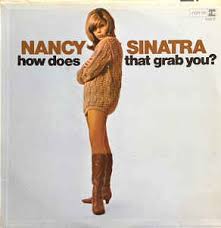 On to Frank’s daughter, Nancy Sinatra, with “How Does That Grab You?” (Reprise, RS-6207) from 1966, Frank’s own label. The first cut, “Not the Lovin’ Kind,” begins with minimal instrumental, as the acoustic bass walks under Nancy’s vocal. There’s a full and rich voicing from the speakers here – I can hear the detail and texture from those slowly plucked strings, as the guitar comped its way into the mix, which prompted me to increase the volume a bit—a very lovely presentation captured in this 1966 outing.
On to Frank’s daughter, Nancy Sinatra, with “How Does That Grab You?” (Reprise, RS-6207) from 1966, Frank’s own label. The first cut, “Not the Lovin’ Kind,” begins with minimal instrumental, as the acoustic bass walks under Nancy’s vocal. There’s a full and rich voicing from the speakers here – I can hear the detail and texture from those slowly plucked strings, as the guitar comped its way into the mix, which prompted me to increase the volume a bit—a very lovely presentation captured in this 1966 outing.
Next up, a spin of Peggy Lee’s “Latin Ala Lee!” subtitled “Broadway Hits With An Afro Cuban Beat” (Capital Records ST-1290, 1960), which delivered a lot of percussions and a fantastic brass orchestra. I know this fun record well… I’ve played it a lot for parties. With the song “Heart,” Peggy’s voice was sweet and clear, and I noticed a slight bit more detail with the PHO-300 and more evenness in the brass.
 The Bill Evans Trio’s “Waltz for Debbie” (Riverside, 1961), recorded live at the Village Vanguard, capturing the intimate sound signature of this famous jazz club. I know this because I’ve heard some acts there myself. With their audience always so very respectful of the artists performing for them, I can hear that beautiful room tone influencing Bill’s piano as this trio plays “My Foolish Heart” – a well-painted picture from this little Vincent Audio phono stage.
The Bill Evans Trio’s “Waltz for Debbie” (Riverside, 1961), recorded live at the Village Vanguard, capturing the intimate sound signature of this famous jazz club. I know this because I’ve heard some acts there myself. With their audience always so very respectful of the artists performing for them, I can hear that beautiful room tone influencing Bill’s piano as this trio plays “My Foolish Heart” – a well-painted picture from this little Vincent Audio phono stage.
At this point, I wanted to compare the PHO-300 with my Bellari VP-130 tube phono preamp. The Bellari is painted a very retro-red and retails for $279.00. I swapped in the Bellari, turned it on, and let it warm up for 10 minutes and then replayed Dean’s “Sleep Warm” record. Although the sound was similar, I noticed the soundstage was slightly veiled compared to the PHO-300’s presentation. The Vincent showed more prowess in every way.
A replay of Peggy’s record and that same song, the percussion presented by the Bellari, had a very nice definition, and the brass was satisfactory. Still, the percussion had more of a foundation and the brass a touch more roundness through the PHO-300. Even though I liked the region of the upper highs through my Bellari’s Mullard 12AX7 tube. Once done, I flipped on the Bill Evans record again. Although enjoyable, this famous piano trio was not as defined as with the Vincent PHO-300 phono preamp.
On To System Two
I planned to take the new PHO-300 phono preamp to our Connecticut house where I have a more substantial rig, but there was a hitch… a recent flood in our finished basement due to a burst water bladder tank had taken out the wood floor of my man cave.
We were home at the time, but the bladder burst in the middle of the night, and we didn’t discover the damage until mid-morning. While the water literally took out the antique wood floor in my listening room, my Hi-Fi system in that finished basement was left unharmed, thanks to its placement on a vertical VTI audio rack. ServPro to the rescue!
 I wasn’t gonna let that get me down. ServPro got the water out promptly and removed the damaged floor. After days of fans going and ac running to take out the humidity, I reassembled my rig upstairs. This rig consists of a modified Well Tempered Record Player, a Conrad Johnson PV-8 tube preamp, and a weighty 75 lb. PS Audio 200CX solid-state power amplifier, with the music voiced through a pair of original ProAc Super Tablettes, augmented by a 10″ powered Infinity subwoofer. In this rig, I use running Synergistic cabling throughout. My tube EarMax PhonoMax, by Brocksieper, a phono preamp made in Germany, completes the setup. The PV-8 has a built-in phono, but the PhonoMax brings things to another level.
I wasn’t gonna let that get me down. ServPro got the water out promptly and removed the damaged floor. After days of fans going and ac running to take out the humidity, I reassembled my rig upstairs. This rig consists of a modified Well Tempered Record Player, a Conrad Johnson PV-8 tube preamp, and a weighty 75 lb. PS Audio 200CX solid-state power amplifier, with the music voiced through a pair of original ProAc Super Tablettes, augmented by a 10″ powered Infinity subwoofer. In this rig, I use running Synergistic cabling throughout. My tube EarMax PhonoMax, by Brocksieper, a phono preamp made in Germany, completes the setup. The PV-8 has a built-in phono, but the PhonoMax brings things to another level.
I powered up the system just to recall its sonics. After some warm-up, I cued the needle on a beautiful sounding 45 rpm pressing of “Dream with Dean” (Analogue Productions 2014), a must-have for any record collector. So simply miked, Dean’s voice is just superb with minimal guitar, piano, bass, and drum accompaniment. You would think a somewhat dry recording would lose the listener’s attention, but in this case, I beg to differ… this record is going with me to my grave! The PhonoMax did a fantastic job engaging one to experience every nuance of detail, with Dean clearly in the room.
Next on deck, another 45 rpm pressing, this one Chris Isaak’s “Blue Hotel” (Reprise, 1987), a W-000 ST, DJ EP special edition pressing. With a total of only 4 songs, I began playing with “Wicked Game.” This song really brings back great memories from the ’80s, and this 45 rpm really enhances the trance-like recording. The sound surrounds you and gives you back massage to boot. It’s exhilarating.
 Last, Shelby Lynne’s “Just A Little Lovin’,” an Analogue Productions 2012 pressing on the Lost Highway label. – the song, “How Can I Be Sure,” a song by Eddie Brigali and Felix Cavaliere. Mastered by Doug Sax, I don’t know how he got this 33 rpm pressing to sound like a 45… it’s just great sounding! From here, I powered down the system, inserting the Vincent Audio PHO-300 for a comparison.
Last, Shelby Lynne’s “Just A Little Lovin’,” an Analogue Productions 2012 pressing on the Lost Highway label. – the song, “How Can I Be Sure,” a song by Eddie Brigali and Felix Cavaliere. Mastered by Doug Sax, I don’t know how he got this 33 rpm pressing to sound like a 45… it’s just great sounding! From here, I powered down the system, inserting the Vincent Audio PHO-300 for a comparison.
After hook up and ample warm-up of the PHO-300, I played the previous songs again. Wow! The sound was quite interesting… I heard the same detail, but there was something else going on here….The PHO-300 exerted slightly more control on the bass and midrange, and the upper highs were smooth and not as glassy. Very subtle, but noticeable. I do love how the PhonoMax renders vinyl, but the PHO-300 is comparing quite well to it. On “Wicked Game,” the sound was equally surrounding with a touch more control over the low frequencies. The highs were slightly laid back, but nothing was lacking. Even in Shelby’s cover of Dusty Springfield’s “How Can I Be Sure.,” the intimate detail was all there, like using a looking glass for your ears.
While the PHO-300 was still in the system and because I couldn’t stopping spinning, I played Saint Saëns, “Organ Symphony No. 3 in C Minor,” conducted by Louis Fremaux for Klavier Records and recorded in 1973, a limited edition Seq. #0199. Klavier Records is known for not compressing the sound on their record pressings, so damage can happen to your speakers if you play too loudly at the peaks. The bass sonics from the pipe organ are where having a subwoofer pays off, and the PHO-300 did a great job reproducing these ultra-low notes… other phono stages might have trouble handling these passages. The church environment shines through brilliantly, with all of its glorious reverberations… for me, this is a good test record.
Just for fun, I spun a wonderfully odd LP titled “Senor Coconut Y Su Conjunto” (Emperor Norton, 1999), a collection of Kraftwerk covers by a Chilean group from Santiago. Sadly, not many people know how good this vinyl record sounds. “Showroom Dummies” is offered in unique instrumentation, with all kinds of percussion and marimbas, etc. In the words of my wife, Pam, “It’s full 100% spectrum sound, filling all parts of the room.” There are so many sounds zinging around, one can’t help but move with the beat. Another excellent demo record!
The Wrap
I don’t know how they could get this phono product to sound as good as it does, but our friends at Vincent Audio really do know their stuff. When it comes to audio engineering, they certainly built this excellent sounding device at a very affordable price.
It’s no wonder Adam wanted me to hear it for myself. I absolutely love the Vincent Audio PHO-300’s design, and its ease of use, and its incredibly affordable price tag is just icing on the cake. I highly recommend the Vincent PHO-300. It’ll surely send you out on a hunt for new and vintage vinyl gems!


Tim Barrall
Specifications:
Vincent Audio PHO-300
Price: $349.95
Contact:
Pangea Audio Distributing
PR Agent: Adam Sohmer
(347) 662 6535
Specifications:
Frequency Response: 10 Hz – 20 kHz (+/- 0,5dB); 10kHz – 50kHz (+/-2dB)
T.H.D.: < 0.05%
Input Sensitivity: MM 58 mV; MC 6.8 mV
S/N Ratio: MM > 83 dB; MC > 70 dB
Input Impedance: MM 47 k Ohm; MC 100 Ohm
Output Impedance: 250 Ohm
Max. Voltage Output: 8 V (per channel)
Amplifier Gain: MM 40 dB; MC 60 dB
Maximum Power Consumption: 10 W
Weight: 2 lbs. (0.9 kg) power supply; 1.3 lbs. (0.6 kg) preamplifier
Dimensions: 4.4″ wide, 2.3″ high, 5″ deep x 2
Tim’s Associated equipment:
Core Power Technologies Equi=Core 1800 (mains filter)
Counterpoint PAC-5 (mains filter)
Conrad Johnson PV-8 preamplifier
PS Audio CX200 power amp
Infinity subwoofer system
PhonoMax phono preamplifier
Vincent SV-200 integrated amplifier
Audio Path power cord
Synergistic Kaleidoscope interconnects
Synergistic Looking Glass interconnects
Synergistic Alpha Quad speaker cables
Sunshine interconnects
Sunshine speaker cable
Pioneer BP22-LR speakers
ProAc Super Tablettes
Stereo Times Masthead
Publisher/Founder
Clement Perry
Editor
Dave Thomas
Senior Editors
Frank Alles, Mike Girardi, Key Kim, Russell Lichter, Terry London, Moreno Mitchell, Paul Szabady, Bill Wells, Mike Wright, Stephen Yan, and Rob Dockery
Current Contributors
David Abramson, Tim Barrall, Dave Allison, Ron Cook, Lewis Dardick, Dan Secula, Don Shaulis, Greg Simmons, Eric Teh, Greg Voth, Richard Willie, Ed Van Winkle, and Rob Dockery
Music Reviewers:
Carlos Sanchez, John Jonczyk, John Sprung and Russell Lichter
Site Management Clement Perry
Ad Designer: Martin Perry






Be the first to comment on: Vincent Audio PHO-300 phono pream by Tim Barrall